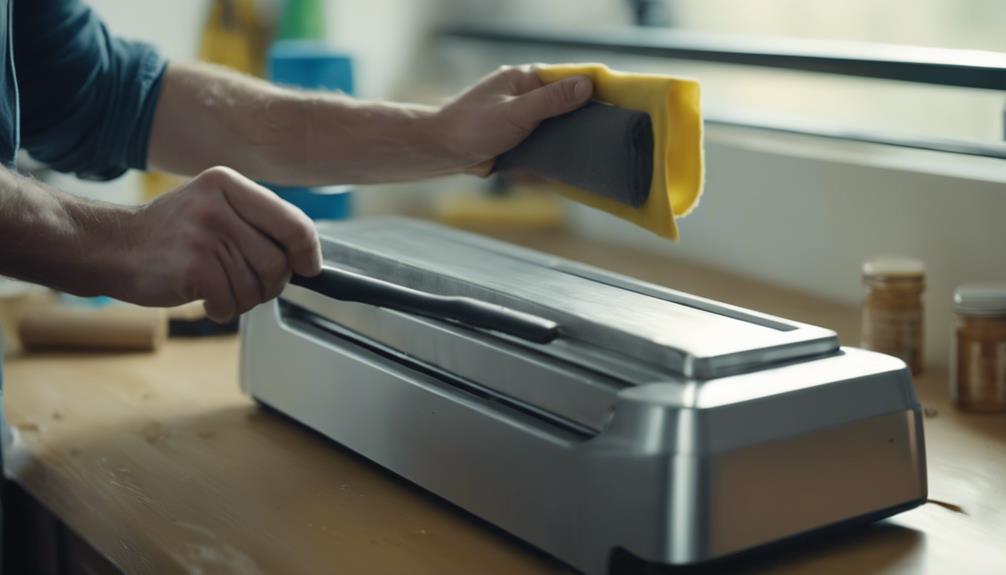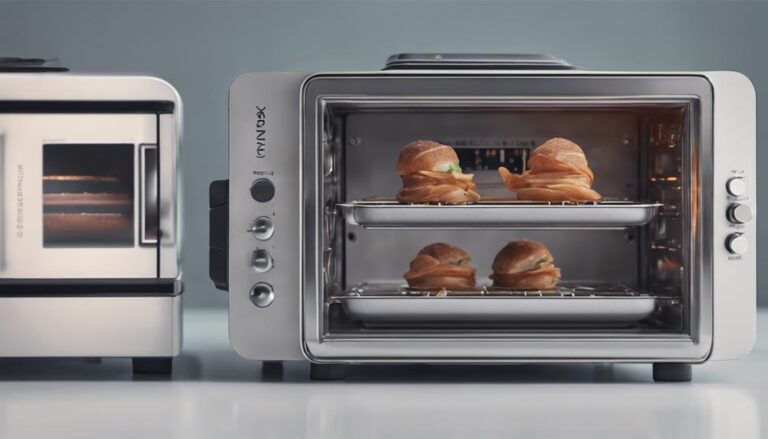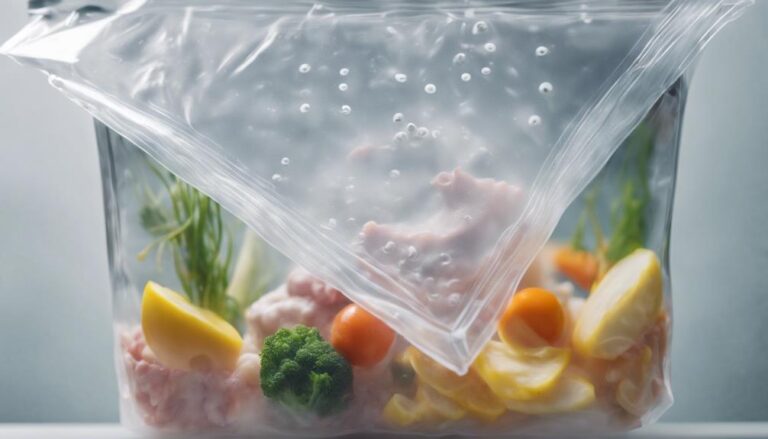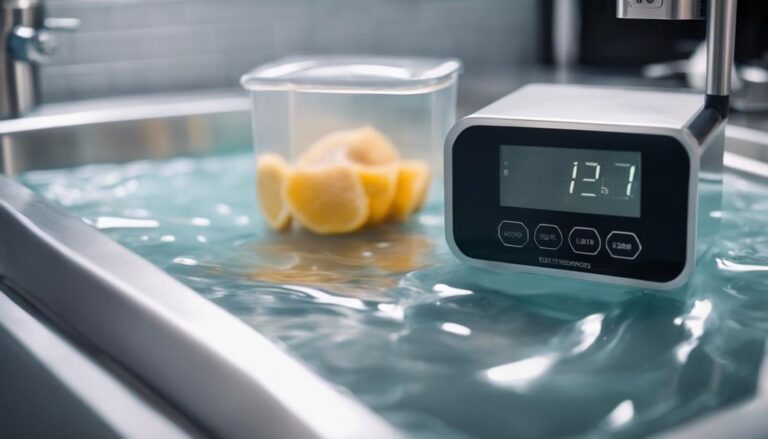Maintaining Your Vacuum Sealer: Care and Troubleshooting
To keep your vacuum sealer in top shape, remember to clean the sealing strip and chamber regularly. Use quality bags for your specific sealer model. Prevent future issues by sticking to a maintenance routine. This way, your sealer will stay in peak condition, maintaining ideal vacuum pressure. These care steps are crucial for efficient food packaging and ensuring your sealer's longevity.
What You Will Learn Here
- Regular maintenance every 6 months prevents breakdowns and extends lifespan.
- Check sealing strip and heating element for wear and functionality.
- Address wrinkles by flattening bags and using high-quality, flat vacuum seal bags.
- Prevent incomplete seals by adjusting seal time and monitoring for debris.
- Follow preventive care routines, cleaning tips, and effective food preparation for optimal performance.
Importance of Vacuum Sealer Maintenance
Regular maintenance of your vacuum sealer every 6 months is essential to prevent breakdowns and costly repairs. By investing time in preventative maintenance, you can catch smaller issues early on, ensuring the smooth operation of your machine. This proactive approach not only helps in avoiding common problems like poor sealing, insufficient vacuum, and machine overheating but also extends the lifespan of your vacuum sealer. Addressing these issues promptly can save you from unexpected downtime and expenses.
Performing maintenance tasks such as changing oil and Teflon tape regularly can prevent challenges like a seized pump, contributing to the efficient functioning of your vacuum sealer. Embracing a regular maintenance routine is key to not only preserving the quality of your machine but also guaranteeing the efficiency of your food packaging processes. Remember, a well-maintained vacuum sealer serves you and your customers best.
Checking Sealing Strip and Heating Element
Inspect the sealing strip and heating element for any signs of wear or damage.
Clean the strip to remove food particles that could affect the sealing process.
Make sure to check the functionality of the heating element to troubleshoot any sealing issues efficiently.
Strip Condition Check
To guarantee a proper seal with your vacuum sealer, regularly inspect the sealing strip and heating element for wear and residue buildup. The sealing strip should be checked for any signs of wear and tear that could impact the sealing process.
Similarly, it's important to examine the heating element for residue or buildup that may hinder its functionality. Keep the sealing strip and heating element clean to ensure top performance.
Remember, maintaining these components is critical for the efficient operation of your vacuum sealer. If you notice any visible wear on the sealing strip, consider replacing it promptly to prevent any sealing issues.
Element Functionality Test
Verify the functionality of the sealing strip and heating element by carrying out a test cycle without any food to guarantee airtight seals and secure packaging for your vacuum-sealed items. Regularly inspect these components for wear and tear to make sure they are in good condition. A well-maintained sealing strip and heating element are vital for efficient vacuum sealing and food preservation. Conducting a functionality test is a simple way to check the effectiveness of these essential parts. Below is a table to guide you through the testing process:
| Sealing Strip | Heating Element |
|---|---|
| Check for any visible damage or debris | Ensure the element heats up evenly |
| Look for signs of wear or discoloration | Verify that the heating element melts the bag material effectively |
| Clean the strip if needed | Test by running a sealing cycle without any food |
| Replace if worn out | Replace if not functioning properly |
Troubleshooting Sealing Issues
For troubleshooting sealing issues related to the sealing strip and heating element, focus on identifying and addressing common causes of incomplete seals to guarantee top vacuum sealing performance.
Here are some steps to bear in mind:
- Confirm proper bag placement on the sealing strip to prevent incomplete seals.
- Keep the sealing components clean from any food particles that could impede the sealing process.
- Regularly check the sealing strip and heating element for any signs of wear and tear.
- Smooth out any wrinkles in the bag before sealing to optimize the vacuum sealing process.
Addressing Wrinkles in Vacuum Seal Bags
Wrinkles in vacuum seal bags can compromise the freshness and sealing effectiveness of your stored items. When these wrinkles occur, they can hinder the proper sealing process, leading to reduced shelf life for your goods.
To address this issue, make sure that the bag is flat and free of any texture issues before sealing. Smoothing out the bag and evenly distributing the contents can help prevent wrinkles during the sealing process. Using high-quality, flat vacuum seal bags is also crucial in preventing wrinkles and maintaining the vacuum pressure within the bag.
Preventive Measures for Seal Quality

To maintain peak seal quality with your vacuum sealer, prioritize regular cleaning and maintenance to prevent potential issues. Here are four preventive measures to make sure your vacuum sealer operates at its best:
- Avoid Overfilling: Prevent leaks and guarantee proper sealing by avoiding overfilling the bags when vacuum sealing. Leave enough space at the open end of the bag to create a proper seal without any obstructions.
- Use Recommended Bags: Always utilize the recommended bags for your specific model of vacuum sealer. Using the correct bags will help maintain a quality seal and prevent any compatibility issues that could impact the sealing process.
- Follow Best Practices: Adhere to best practices for sealing, such as ensuring the bag is properly positioned in the sealer and cleaning the sealing area regularly. Proper techniques can help prevent problems and maintain efficient sealing.
- Establish a Maintenance Routine: Implement a maintenance routine for your vacuum sealer to keep it in prime condition. Regularly cleaning the machine and checking for any signs of wear and tear will help extend its longevity and ensure consistent sealing performance.
Troubleshooting Incomplete Seals
If you're experiencing incomplete seals with your vacuum sealer, adjusting the seal time and checking for any debris on the sealing strip could help guarantee the issue.
Taking these simple steps can enhance the effectiveness of your vacuum sealer and guarantee airtight seals for your food items.
Remember to regularly maintain and inspect your vacuum sealer to address any potential sealing problems promptly.
Seal Time Adjustment
Adjusting the seal time on your vacuum sealer is crucial for troubleshooting incomplete seals. When faced with incomplete seals, follow these steps to fine-tune the seal time effectively:
- Check Settings: Confirm the seal time is set to the appropriate duration for the type of bag being used.
- Adjust Gradually: Make small modifications to the seal time to find the best setting for a secure seal.
- Test Seals: After each adjustment, test the seal on a bag to verify the effectiveness of the change.
- Monitor Consistently: Regularly check the seals to confirm that adjustments have resolved the issue and maintain freshness.
Check for Debris
Examine the sealing strip of your vacuum sealer for any debris to troubleshoot incomplete seals effectively. Debris or food particles stuck on the sealing strip can impede a proper vacuum and seal.
Regularly check and clean the sealing strip to guarantee it's free from any obstructions that could compromise the sealing process. Residual food particles left unattended may lead to sealing issues, impacting the freshness and longevity of your vacuum-sealed items.
Maintaining Vacuum Pressure
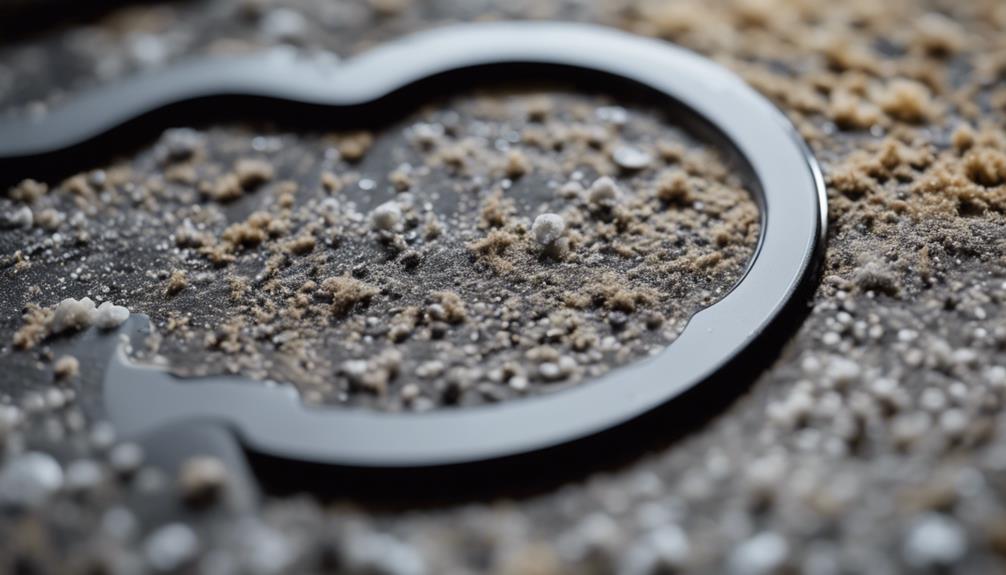
To maintain peak vacuum pressure in your sealer, prioritize regular cleaning and maintenance. Neglecting these tasks can lead to decreased performance and potential issues with sealing.
Here are some tips to help you maintain ideal vacuum pressure:
- Avoid Overfilling Bags: Overfilling bags can cause leaks, compromising the vacuum pressure. Make sure to leave enough space at the top of the bag to guarantee a proper seal and maintain the vacuum pressure.
- Use Recommended Bags: Using the appropriate bags for your specific vacuum sealer model is vital. Different sealers may require different types of bags to sustain the correct pressure levels. Always refer to the manufacturer's recommendations.
- Follow Best Sealing Practices: Proper sealing techniques are essential for maintaining vacuum pressure. Ensure the bags are correctly sealed to prevent air from entering, which can impact the pressure inside the bag.
- Adopt Preventive Care Routine: Implementing a preventive care routine can help you avoid potential issues with vacuum pressure in your vacuum sealer. Regularly inspect and maintain your sealer to ensure it functions optimally.
Cleaning and Bag Usage Tips
To maintain ideal vacuum pressure in your sealer, start by making sure that you regularly clean the sealing strip and vacuum chamber to prevent any issues during the sealing process. Use high-quality bags and rolls designed for your specific vacuum sealer model to guarantee proper sealing.
Avoid overfilling the bags and leave at least 1 inch of space between the food and the edge for effective sealing. Before vacuum sealing foods like meats or fruits, blot excess moisture to prevent interference with the sealing process. Smooth out any wrinkles in the bag before sealing to ensure peak vacuum pressure and a tight seal.
Frequently Asked Questions
How Do You Maintain a Vacuum Sealer?
To maintain a vacuum sealer, clean regularly and follow a maintenance schedule. Troubleshoot common issues promptly and store properly. Use recommended parts, practice preventative measures, and follow usage tips to keep your sealer efficient.
Why Is My Vacuum Sealer Vacuuming but Not Sealing?
If your vacuum sealer is vacuuming but not sealing, examine for dirty sealing bars, worn-out coverings, broken seal elements, or incorrect settings. Confirm proper maintenance, troubleshoot power issues, and address air leaks or overheating to resolve sealing problems effectively.
What Precautions Should Be Taken When Using a Vacuum Sealer?
When using a vacuum sealer, remember safety measures, proper storage, cleaning tips, and preventing malfunctions. Keep the sealing area clean, use recommended bags, avoid overfilling, and inspect for wear. Follow maintenance guidelines for best performance.
Why Is the Dry and Moist Light Flashing on My Foodsaver Vacuum Sealer?
When the dry and moist lights flash on your FoodSaver vacuum sealer, it signifies the type of food being sealed. Understanding these indicators helps in troubleshooting common issues and error messages, ensuring proper sealing for different foods.
Conclusion
Overall, taking care of your vacuum sealer is crucial for ensuring peak performance and prolonging its lifespan.
By regularly checking the sealing strip and heating element, addressing wrinkles in vacuum seal bags, and following preventive measures, you can maintain seal quality and prevent issues like incomplete seals.
Additionally, keeping the vacuum pressure in check, cleaning the sealer regularly, and using high-quality bags will help you get the most out of your vacuum sealer for years to come.
